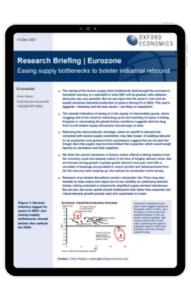Easing supply bottlenecks to bolster Eurozone industrial rebound

The easing of the severe supply-chain bottlenecks that brought the eurozone’s industrial recovery to a standstill in early 2021 will be gradual, with setbacks along the way very possible. But we see signs that the worst is over and we expect eurozone industrial production to grow a strong 4% in 2022. This year’s laggards – Germany and the auto sector – are likely to outperform.
What you will learn:
- The clearest indication of easing is in the supply of intermediate goods, where clogging due to the massive restocking cycle and hoarding of inputs is fading.
- Progress in vaccinating the global factory workforce suggests that the drag from Covid-related supply disruptions should begin to fade.
- Resolving the semiconductor shortage, where an upshift in demand has coincided with severe supply constraints, may take longer.
Tags:
Related Services

Post
Eurozone: Little sign of harm from the Red Sea disruptions
The impact of Red Sea shipping disruption on the eurozone economy continues to be limited, in line with our baseline view. Our new Eurozone Supply Stress Indicator suggests that supply pressures have returned to normal following a period of easing in 2023.
Find Out More
Post
GCC: Key themes shaping city economies in the near term
For Gulf cities, the near-term outlook will be tied not only to the global macroeconomic backdrop, but also the progress of the diverse visions and strategies in the region. With the aim to diversify their economies and reduce the dependence on oil, Gulf states continue to invest in the non-oil economy and implement various reforms. That said, oil revenues remain key to funding diversification efforts.
Find Out More